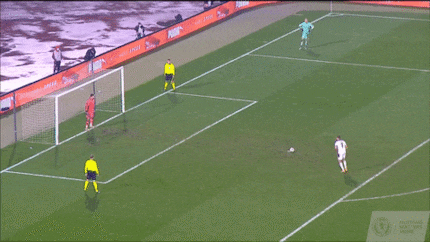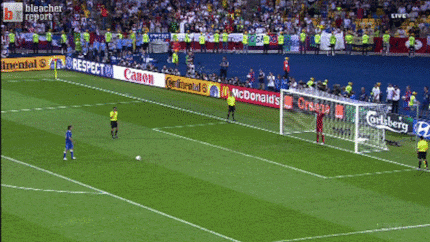
Guide
Hockey again at last: what you need at home or in the arena
by Stephan Lamprecht

Hero here, loser there – rarely are roles at the European Football Championship as clearly distributed as during a penalty shootout. In this case, the conditions for both the keeper and striker are opposite from those of Western heroes: whoever acts first loses.
It’s been decried as a matter of luck, castigated as unfair, yet it’s the highlight of every tournament: the penalty shootout. When weary players line up for the final shot, everyone’s pulse rises. Even Americans get into «soccer» then. This duel between striker and keeper always leads to drama. One will lose. Usually, the goalkeeper has worse odds but less pressure. Statistically, they should block every fourth shot or force the shooter to miss by virtue of their aura. At least if you go off previous penalty decisions at World and European Championships. There have been 41 shootouts in total, and exactly 73.2 per cent of the 395 shots taken resulted in a goal.
I’m interested in statistics such as these, although I still know relatively little. I sit in front of my TV thinking, «He’s nervous! He’ll miss.» – just as the ball flies into a corner. Or my conviction that Cristiano Ronaldo will always score, usually ending in an impressive miss. Will England always lose come the shootouts? Nope, coach Gareth Southgate of all people made it work! Although he’s still haunted by his own miss in the semifinals of the 1996 European Championship.
There are no certainties in football. Which is precisely why everyone clings to the bare facts and tries to plan for the unplannable. Frontiers in Psychology had a go, trying to determine which strategy will turn out particularly promising for protagonists in a penalty shootout. Should be interesting. After all, we all know: all players can kick the ball, but penalty shootouts are a matter of the mind. That’s what makes this relatively simple task so difficult. It’s a question of choices, and the right ones. The main characters, at this moment the centre of the football universe, move in a field of tension between space and time. Or rather spatial and temporal behaviour, as it is scientifically called. They can choose a corner. And they can play for time. Delay until the opponent flinches. But what is truly the best play?
If the striker absolutely pounds a well-aimed shot, the goalie only has to decide on where to go early. After, it takes less than half a second for a ball to hit the back of the net. That’s too little time to react. Goalies have a clear behavioural preference during the penalty shootout. In two out of three shots, they react late, which according to the above study is at most 0.16 seconds before the shot occurs. This being approximately the moment when the kicker sets up their supporting leg. In these cases, keepers hope for a poorly placed ball. Or on a player who wants to wait for their reaction. Very few shooters dare to do this. Three out of four take their hearts in their hands, aim for a corner and hope it goes well. It usually does when the goalie hesitates.
Success rate when the goalie reacts late: just under 80 per cent
Only in every third penalty does a keeper decide on a corner «early», meaning at least 0.2 seconds before the shot. A pre-emptive reaction invites the kicker to slide it in, but only one in four dares to do so. The rest go through with their preconceived plan and hit it. If a striker aims at the upper third of the goal, the goalkeeper can almost only hope for a miss. But if they aren’t up for that, an early reaction is their only hope.
Success rate when the goalie responds early: 60 per cent

Starting off slowly, delaying until the goalie flinches, then pass it in easily. This can appear either absolutely safe and controlled or completely idiotic. Anyone who dares to do something like this definitely has self-confidence. They seek to duel instead of blocking out their opponent. Various cues reveal which strategy a shooter is going for: how long they look at the goalkeeper, how fluidly they start. Those who pay attention to the goalie are more likely to use the inside of their foot. And quite succesfully at that. Especially when the goalkeeper decides to take a corner early.
Success rate when the goalie reacts early: just under 82 per cent
On the other hand, this strategy becomes significantly more risky when a keeper guesses your plan and waits a long time themselves. Then there’s an acute risk of embarrassment for the shooter. Nevertheless, their chances of success aren’t that bad.
Success rate when the goalie reacts late: just under 64 per cent
Statistically speaking, shooters who are able to still make spontaneous decisions despite the pressure do somewhat better. As a result, rare «passing» goals really hype up the fans. If they fail, they fail miserably. A spirited full-throttle shot that soars past the goal is more likely to be forgiven, although the action is similarly mindless.
Serenity is key. Few have probably studied the penalty issue as intensely as sports scientist Geir Jordet from Oslo. Among other things, he notes that composure in execution delivers measurable results. If the kicker carefully sets up the ball and takes longer than a second to do so, they score 80 per cent of the time. Those in a hurry only get around 58 per cent. A similar effect is seen after the referee’s whistle. Unsure players who shoot immediately hit less often. So stay cool, take your time.
If your ball goes into the back of the net, you’d better celebrate heartily: players who are properly pleased after their goal instead of sneaking back relieved are 82 per cent more likely to walk off the field as winners in the end. Ideally through a crowning conclusion. The very first penalty shootout at a European Championship in 1976 was as cheeky as it can get. That soft flop into the centre of the goal is still associated with the name of its kicker today. The «Panenka» is a variant that only the greatest players will even dare to attempt. Such as Andrea Pirlo in 2012.

What’s even more unbelievable is that he scored in exactly this way. Allegedly, Pirlo didn’t even know what he was about to do. And Panenka’s original had a statistical advantage: if there’s a chance for a winning goal, your success rate rises to over 90 per cent. This is exciting, but in the end it doesn’t really matter at all. Because here’s what I know to be 100 per cent true: this European Championship, too, will feature some extraordinary penalty shootouts.
Simple writer and dad of two who likes to be on the move, wading through everyday family life. Juggling several balls, I'll occasionally drop one. It could be a ball, or a remark. Or both.
Practical solutions for everyday problems with technology, household hacks and much more.
Show all